Tread lightly in burned pastures |
| By Amber Friedrichsen, Managing Editor |
|
|
 Wildfires throw a wrench into grazing plans in regions prone to such disasters. Even though pasture and rangeland fires delay forage regrowth and set back grazing schedules, perennial grasses typically make a comeback — and grazing recommendations post-wildfire are less strict than they used to be. “Wildfires can leave producers wondering how to manage burned pastures, but the good news is that perennial grasses are resilient and will recover,” Bethany Johnson, Jerry Volesky, and Mitch Stephenson write in a University of Nebraska-Lincoln (UNL) Extension article. Depending on when they occur, wildfires can have variable effects on forage regrowth and subsequent grazing opportunities. For instance, fires during the dormant season will have less of an impact on spring growth since belowground growing points will likely be unharmed. Forage will suffer more damage if wildfires occur May through August when plants are actively growing. The authors state that previously drought-stressed pastures will likely be slower to bounce back from wildfire damage, especially if rainfall is limited during the critical recovery period between May and June. They also note that a surge in annual weeds is common — and usually temporary — post-wildfire. Volesky, a range and forage specialist, suggests many previous post-wildfire grazing recommendations were more conservative than necessary. Now, research shows restrictions do not need to be as stringent, as long as farmers are mindful of the following. Protect the soil. Wildfires leave the soil surface vulnerable to wind and water erosion. Monitor bare ground that is exposed when plant residual and plant litter burn. The goal is to build up biomass in these areas of the pasture to protect that soil, the specialists assert. Research from eastern Nebraska evaluating the effect dormant season prescribed fires have on forage regrowth shows no difference in grass production the summer following a fire. Although prescribed fires are not the same as wildfires, the researchers suggest affected pastures have a similar response to both. With that said, Stephenson, a range management specialist, says the amount of plant residual and plant litter present at the time of a fire impacts the amount of soil exposed after a fire. More plant material translates to more bare ground. Delay grazing. The specialists advise waiting as long as possible before turning livestock out to graze after a wildfire. In normal precipitation years, they recommend delaying turn out by one to two months — wait longer if drought conditions persist. Reduce stocking rates. Destock pastures by 20% to 40% under normal precipitation conditions, or more if dry weather stands to impair pasture recovery. The longer farmers wait to graze affected fields, the less critical lower stocking rates become. For example, if grazing is delayed until late summer or fall, pastures could potentially support full stocking rates if plant residual has been reestablished and fully covers bare soil. Monitor May and June rains. Early season rainfall is more important to pasture wildfire recovery than late-season precipitation. Given adequate moisture in May and June, the specialists expect burn areas to be recovered by mid-summer. With that said, dry weather and drought conditions will further stress burned pastures, which will prompt more cautious grazing. Flash graze immediate regrowth. “If you’re pasture is dominated by cool-season grasses like smooth bromegrass, a quick grazing in early spring, sometimes called flash grazing, can help knock down smooth bromegrass and promote the growth of warm-season annuals,” the specialists state. |
